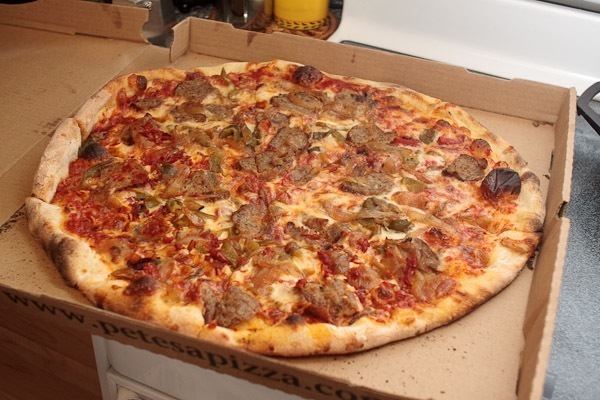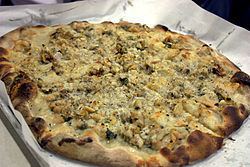Alternative names Apizza Region or state New Haven, Connecticut | Type Pizza Place of origin United States of America | |
 | ||
Created by Frank Pepe Pizzeria Napoletana Main ingredients Pizza dough, tomato sauce, pecorino romano Similar Italian tomato pie, St Louis‑style pizza, Detroit‑style pizza, Quad City‑style pizza, New York‑style pizza | ||
New Haven-style pizza, locally known as apizza (/əˈbiːts/, from Neapolitan ’a pizza ([ə ˈpit͡s(ə)]) "the pizza"), is a style of Neapolitan pizza common in and around New Haven, Connecticut. It originated at the Frank Pepe Pizzeria Napoletana and is now served in many other pizza restaurants in the area, most notably Sally's Apizza and Modern Apizza. This geographically limited pizza style has been favorably referenced by national critics.
Contents

Characteristics

In a New Haven-style pizzeria, a "plain" pizza is crust, oregano, and tomato sauce with a little bit of grated pecorino romano cheese sprinkled on. Mozzarella (known as "mootz" in the local Italian dialect) is considered to be a topping; a customer who wants it must ask for it.

Pepe invented the "white clam pie." Pepe's restaurant used to serve littleneck clams on the half shell at the bar which he eventually decided to put on the pizza. The white clam pie is crust, olive oil, oregano, grated cheese, chopped garlic, and fresh littleneck clams.

What makes New Haven style pizza distinct is its thin, oblong crust, characteristic charring, chewy texture, and limited use of melting cheeses. It tends to be drier and thinner than, but closely related to, traditional New York style pizza. Both styles in turn are close descendants of the original Neapolitan style.
Cooking and serving methods

New Haven-style pizza is traditionally baked in a coal-fired oven at extremely hot temperatures in excess of 650 °F and is sold whole rather than by the slice.
Availability
Although most commonly available in the New Haven area, New Haven-style pizza has begun to spread to other parts of Connecticut. It has been available in the Italian-American areas of Bridgeport, and other shoreline communities for many years. It is beginning to be served in areas typically not known for large Italian-American populations, including towns in northern and central Connecticut as well as farther away in Hood River, Oregon, Washington, DC, Chicago, Illinois, San Diego, California, West Chester, Pennsylvania, Key West, Florida, Austin, Texas, Farmington Hills, Michigan, and Tokyo, Japan.
